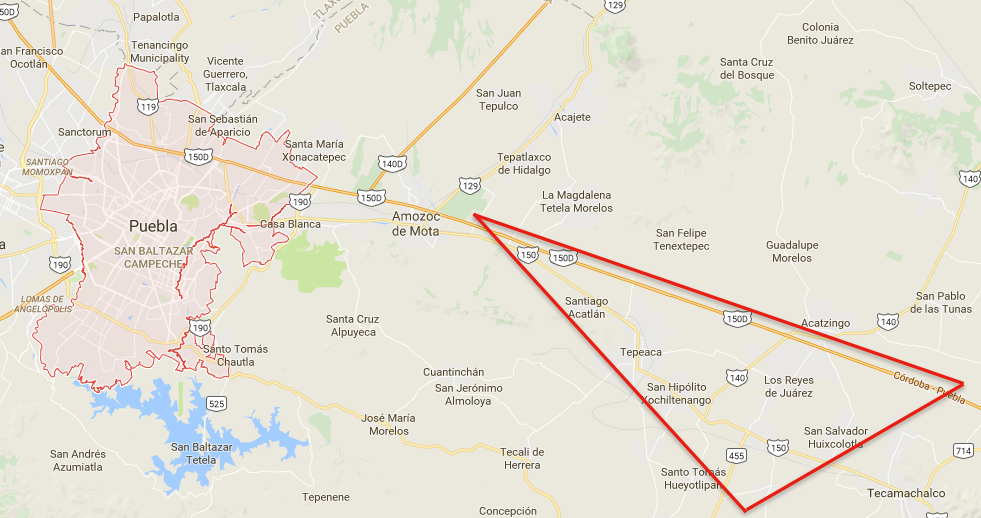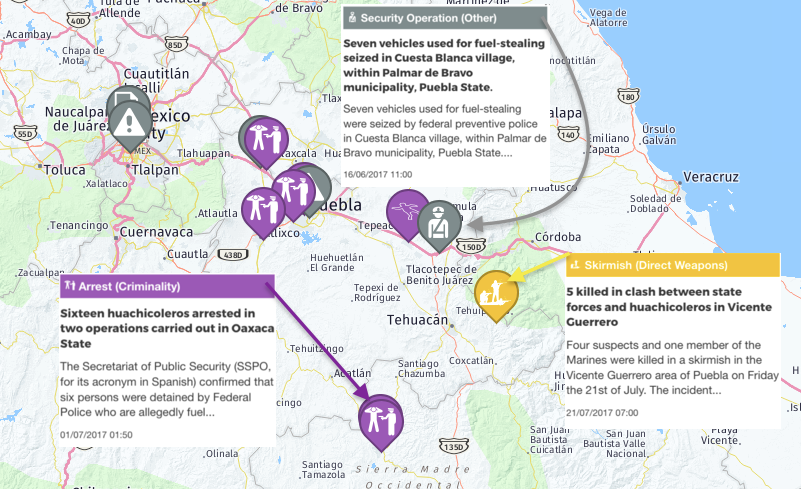Fuel Theft in Central Mexico: A 2018 Priority
The trade of huachicol, or stolen petrochemicals, is a burgeoning problem for both law enforcement and the energy sector in Mexico. Those who steal the petroleum, known locally as huachicoleros, or chupaductos, have damaged the country’s nationalised industry, siphoned significant resources, and funnelled billions of pesos of alternative funding into larger criminal enterprises such as narco-trafficking. As the crime has proliferated and its yields become more severe, it has quickly risen up the law enforcement agenda. As with any issue of this magnitude, there may be solutions that are long-term and holistic, and others that are narrower and more short-term. In order to seek effective counter-action, a number of the huachicolerosâ features must be understood. These include their origins, justifications, geographical trends, modus operandi, and the identities of key individuals involved.
The Rise of Los Chupaductos
While fuel theft in some form has of course existed for as long as the energy sector, modern huachicolero activity (the term huachicol originally referred to an unfiltered alcoholic cane drink) was first noticed as a serious problem between 2009 and 2011. Only 310 illegal pipeline outlets were located in 2009, but between 2011 and 2016, they multiplied five-fold. Crucially, this sharp increase took place entirely under the Puebla governorship of Rafael Moreno Valle, who took over from Mario Marin in 2010. Both political corruption and negligence evidently contributed to the spread of fuel theft.
The illicit seizure of fuel has been reported in 22 of Mexicoâs 31 states, and constitutes a new focus for many local news outlets. While Guanajuato, Tamaulipas, and Veracruz have all seen spikes in the activity, the area of Puebla known colloquially as the âRed Triangleâ (Figure 1) has been experiencing the greatest incline in the stealing and illicit distribution of petrochemicals since 2013. The area contains 40% of the petroleum pipelines radiating from Mexico City, all of which are maintained by the countryâs national energy company, Petróleos Mexicanos (PEMEX). The Red Triangle encapsulates the municipalities of Tepeaca, Palmar de Bravo, Quecholac, Acatzingo, Acajete, and Tecamachalco, which have collectively situated around 90% of the illegal pipeline âtapsâ.

Figure 1: The âRed Triangleâ, east of the city of Puebla
According to a PEMEX report presented to the Mexican Navy, the Office of the Attorney General, and a number of government ministries, the practice of fuel theft (which targets raw oil, petroleum, diesel, and processing chemicals) now costs the country the equivalent of USD $1bn annually. Costs are incurred from resource losses, pipeline repairs, and subsequent security operations. For example, over 6,300 clandestine taps were located in 2016, in total costing four billion pesos in reparation.
PEMEX forecasts an average daily output of 1.2 million barrels of petrochemicals for the 2017 calendar year. Around 26,000 barrels per day (around 2%) are now estimated to be lost to huachicoleros nationwide. According to regulators, however, some local fuel stations lose up to 50% of their fuel to theft.
Each litre stolen has a street value of between seven and eight pesos, and is either sold to drivers on the road or wholesale to local businesses and factories. The state of Puebla is a comparatively wealthy one, however the majority of its productivity remains in its capital city; for hundreds of families residing in the Red Triangle, which has an 80% poverty rate, the black market now represents a main source of income.
Theft Operations
Los chupaductos translates as âpipe suckersâ, which illustrates the thievesâ modus operandi. PEMEX ducts are located and unearthed by the operatives, often on discrete agricultural land. The line is drilled and into it is placed a bypass valve. Plastic hoses are inserted and the fuel is siphoned into containers up to four kilometres away. The majority of the liquid is transported to industrial customers and sold in bulk. Alternatively, it can be taken to individual buyers on the Central Mexican roads, or stored at its source where access to the âfuel poolsâ may then be charged at up to 500 pesos.
The trade has penetrated the United States, where fuel is more often stolen with false credit cards. Miami, Los Angeles, and Las Vegas now collectively lose 80 million litres annually, and the black market can generate $1,000 per day (particularly on the Interstate 10 highway between Florida and California), making it more lucrative than other more violent criminal pursuits.
Evidently, fuel theft is a mostly decentralised, opportunistic exploit, and the huachicoleros are no one group. However, their success has attracted organised criminals with broader links in other illicit trades. Members of the El Bukanas gang, which has links to the Los Zetas cartel and is suspected of involvement in extortion, murders and kidnappings in a number of Mexican states, were caught conducting operations of this kind in Cuesta Blanca in March 2017. For El Bukanas operatives such as Gustavo Jiménez MartÃnez (alias âEl Viejaâ) and Noé Bernardo Silva (alias âEl Cucaâ), this possibly indicated a significant transition from narcotics cultivation to fuel theft, a lucrative industry with comparatively fewer risks. In Guanajuato, the state Attorney General has identified another organised criminal, Jouan Antonio Yépez (alias “El Marro”), as the main target of police efforts against the trade of huachicol.
Journalist Ernesto Aroche has stated that the huachicoleros âestablished networks of complicity with authorities at all levels and, more importantly, with society … They became their benefactors, gave them jobs, the possibility of getting out of poverty”. This correctly indicates two key aspects of the crimeâs emergence: community trust, and political complicity. The former is reminiscent of a strategy of some South American narcotics traffickers, whereby the group represents access to cheap and important resources, especially when the federal supply drops or prices rise. This persuasive mechanism may be employed while the industry is still comparatively less violently contested, and is strategically employed particularly on public holidays. Also key to the huachicolerosâ business is political allowance. In the central case of Puebla, fuel-related corruption was highlighted by the arrest in July 2015 of Antonio Estrada López, Director of the State Police, and Tomás Méndez Lozano, Head of the Special Operations Group. Dozens of police and several mayors in the Red Triangle Area have been linked with fuel theft, leading a Secretary of Public Security of Moreno Valle, Facundo Rosas Rosas, to resign.

Figure 2: Some fuel theft related incidents reported by Intelligence Fusion
Responses
PEMEX now has an emergency hotline on its website for the specific alert of clandestine pipelines. It has requested from the government eight surveillance teams, a new vehicle check regime, and tighter gas station security. However, if the black market grows further, the corporation will be forced to adapt or decline.
At least thirteen people have been killed in the three attempts to capture Roberto âEl Bukanasâ, the leader of his eponymous crime group. But, it is not the use of force that has evidently deterred criminal activity so much as surveillance and judicial sanctions. In some hotspots in Puebla, a 40% increase in petrochemical resale prices has correlated with tighter watches over PEMEX lines. In turn, the enforcement of a maximum two million peso fine for fuel theft is intended to provide a temporary stopper to a financially motivated criminal epidemic. These measures indicate perhaps more sensible approaches than those against larger organised crime threats, however a full solution is inevitably much more far-sighted.
While a link can be drawn between the huachicol trade and the narcotics industry through the Zetas involvement, the two commodities possess entirely different dynamics. While cannabis can be grown by anyone, for example, petrochemicals are only available through federally controlled refineries. In effect, the Mexican government controls the vast majority of the fuel market through PEMEX, which it cannot do with regards to drugs. The federal government maintains, therefore, a capacity to pressurise illicit activity with economic instruments: the alteration of supply, or the subsidisation of fuel to re-attract licit demand. This is no easy fix, however, given the state-specific problem of huachicol in Puebla and some of its neighbours. A federally altered fuel economy may prove chaotic.
In essence, ordinary Mexicans are attracted to the huachicol industry because of the entrenched socio-economic factors of income inequality and poverty. An increased participation by organised criminals, however, will quickly catalyse the damage and introduce a violent competitive element. To prevent this, there may be a window of opportunity for the state governments of the areas affected (particularly Puebla) to react. If huachicol is understood as a problem that rests on the dual requirements of public amity and political corruption, they may constitute the targets of a balanced counter-measure.
Sources:
Intelligence Fusion reports by the author and Celia Munez; PEMEX; Mexican Federal Audit Office; Milenio; Justice in Mexico; Trading Economics; El Financiero; Sin Embargo; Lado B; El Universal.
